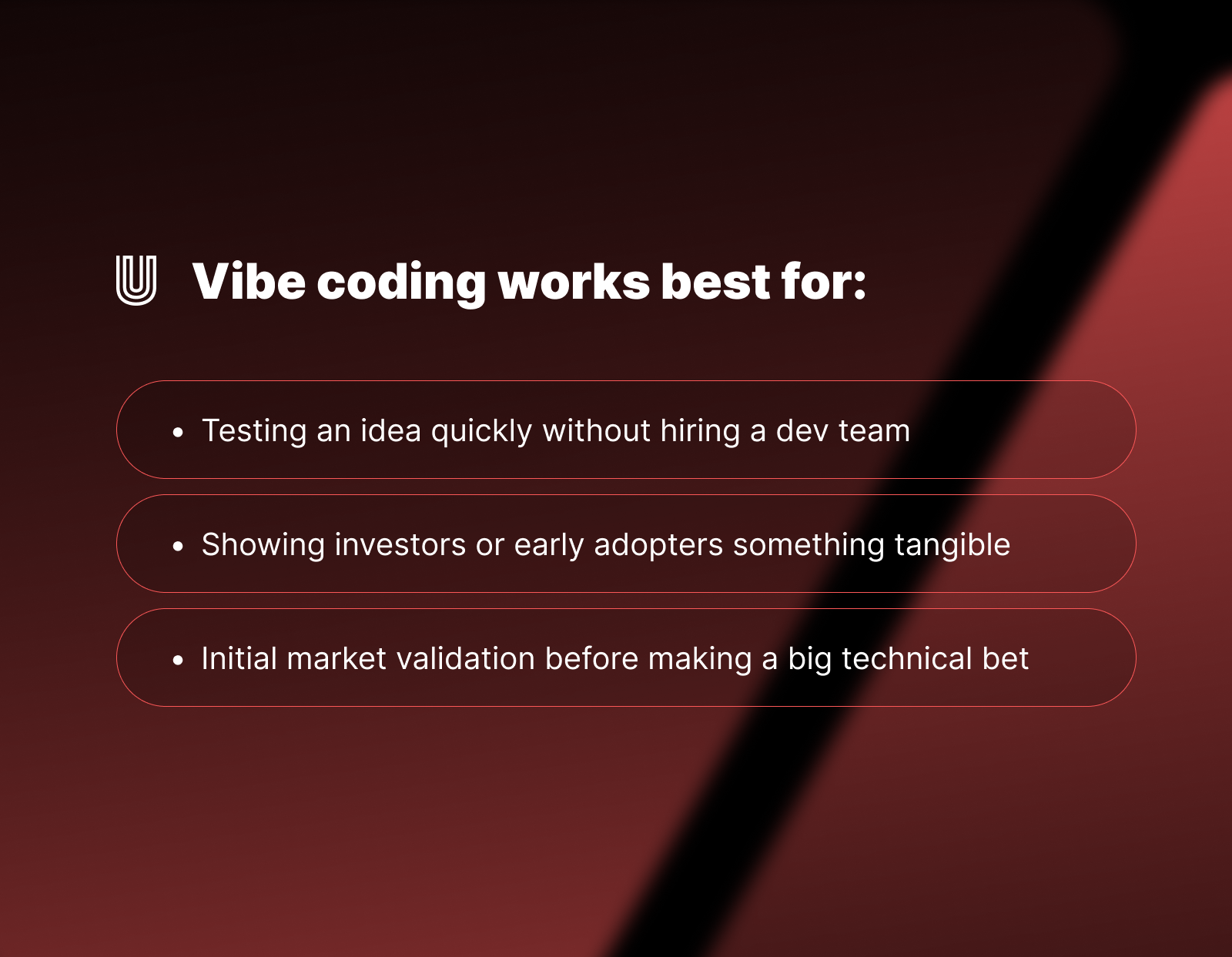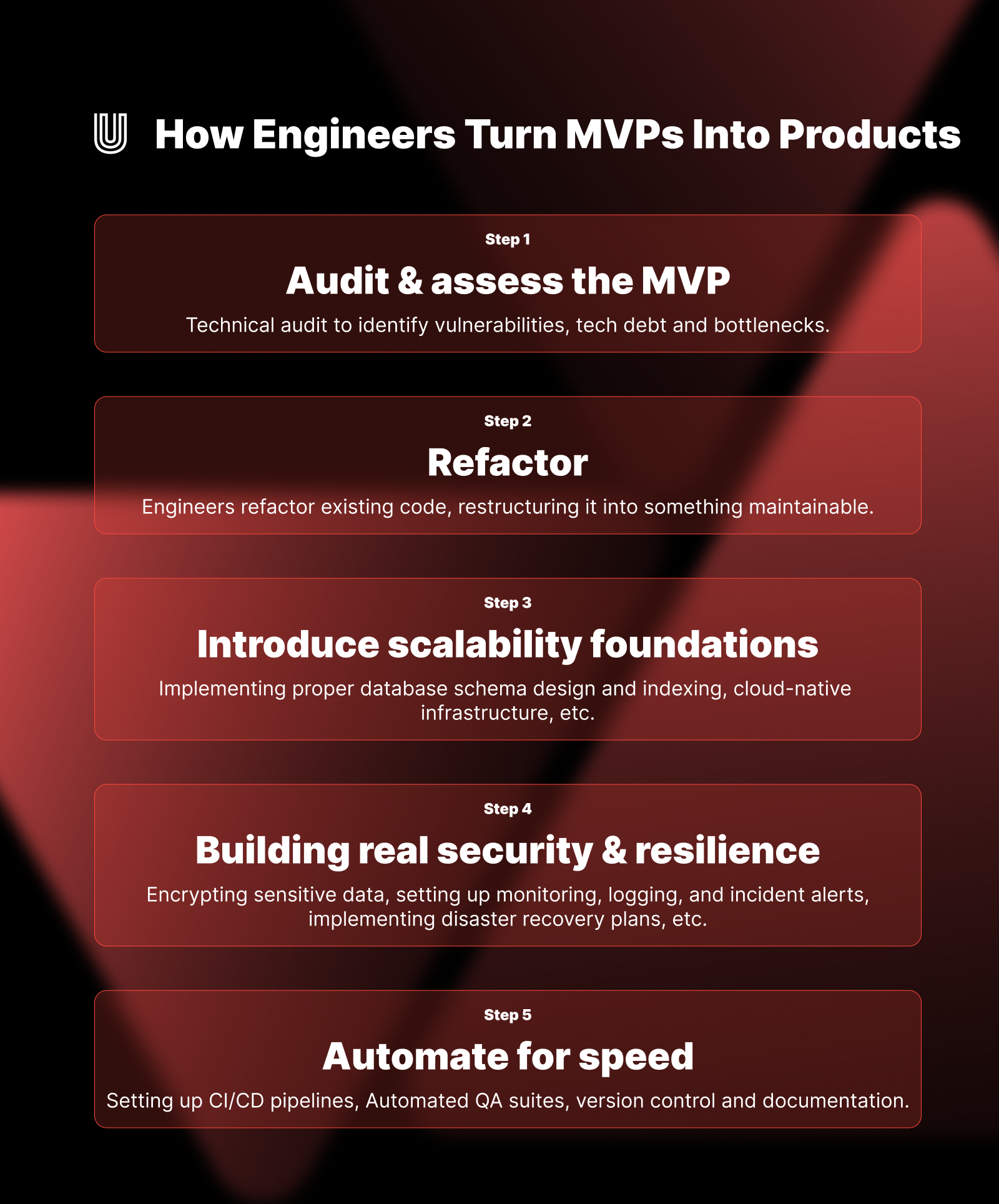Key Takeaways
- Vibe coding is about speed over structure - great for validating ideas fast with no-code, lightweight stacks, or AI.
- Founders benefit by proving traction cheaply, but self-coded MVPs aren’t production-ready.
- Engineers benefit by prototyping quickly, then refactoring into scalable products.
- Typical issues: fragile code, missing security, shaky architecture, poor UX.
- Best path forward: Refactor, don’t rebuild - clean up MVPs into stable, scalable systems.
What Is Vibe Coding?
If you’ve ever hacked together a project over a weekend to “see if it works,” you’ve done vibe coding.
Vibe coding is the practice of building an MVP quickly, using intuition and minimal structure, without worrying too much about clean code, scalability, or long-term maintainability. It’s about speed, not polish.
For example, vibe coding often involves:
- No-code and low-code platforms like Bubble, Webflow, Glide, or Adalo, where founders can drag-and-drop their way to a working prototype.
- Generative AI tools like ChatGPT or GitHub Copilot to spit out snippets of code that “just work.”
- Hackathon-style stacks - quick setups with Firebase, Airtable, or Google Sheets powering the backend.
This approach works brilliantly for:

But vibe coding has a natural limit. It’s great for experimenting, not for scaling. Once you move past proof-of-concept, those “quick wins” often become technical debt that blocks product growth.
Who Really Benefits from Vibe Coding?
Non-Technical Founders (Self-Founders)
For entrepreneurs without a tech background, vibe coding is empowering:
- Rapid idea validation: Launch a basic version quickly.
- Low investment of time and money: No need for a team right away.
- Proof of traction: Test whether people are interested before committing resources.
What’s the challenge? Self-coded MVPs are rarely robust enough for production. They often lack stable architecture, security best practices, and optimized performance, the things investors and users expect once traction grows.
Software Engineers
Professional developers also benefit from vibe coding, but in a different way. When engineers build fast prototypes, they:
- Cut time-to-market by creating proof-of-concept quickly.
- Validate assumptions before investing in architectural overhead.
- Lay groundwork for a codebase that can later be refactored into production-quality systems.
The key difference: what a skilled software engineer brings is the ability to refactor instead of rewriting your MVP. They understand how to evolve a vibe-coded foundation into a clean, scalable, and secure product.
Why Self-Built MVPs Are Rarely Production-Ready
For first-time founders, getting an MVP working at all feels like a huge win - and it is. But it’s critical to understand the difference between an MVP that works for demo-day and a production-ready MVP that can handle growth.
When non-programmers build MVPs themselves, these common issues usually appear:
Fragile Code That Doesn’t Scale
Most self-built MVPs are held together with shortcuts: hardcoded values, inconsistent naming, or patchwork solutions copied from Stack Overflow. This works fine with 20 test users, but at 200 or 2,000 users:
- Performance tanks because there’s no consideration for database efficiency or load balancing.
- Tiny bugs multiply as new features are duct-taped onto the codebase.
- Hiring developers later becomes expensive since they often need to rewrite components just to work with them.
Hidden Security Risks
Security is rarely top-of-mind when founders are hacking together an idea. But the stakes escalate quickly once real users arrive. Common risks include:
- Storing passwords or sensitive data without encryption.
- Using vulnerable third-party libraries without patching them.
- No safeguards against common attacks (SQL injection, XSS, authentication bypass).
Founders underestimate this risk — but investors, due diligence teams, and savvy users do not. A security incident can instantly kill momentum.
Lack of Clear Architecture
When founders vibe-code alone, the app usually grows “organically”, meaning features are bolted on wherever they fit. The result is:
- No modular structure, which makes adding new features slow and risky.
- Difficulty onboarding engineers, since the code lacks documentation or a logical flow.
- Accumulating technical debt — the longer it’s left unaddressed, the more expensive it becomes to clean later.
User Experience Gaps
Non-technical MVPs often focus on “does it work?” rather than “how does it feel to use?” Production apps need:
- Fast load times.
- Mobile responsiveness.
- Intuitive flows and consistency.
From Vibe to Viable: How Engineers Turn MVPs Into Products
Taking a self-built MVP that proves demand and evolving it into a production-ready product requires structured engineering work. Unlike starting from scratch, this process is about making smart use of what already exists, while removing blockers that prevent growth.
Here’s how professional developers transform vibe-coded apps into stable software:

1. Audit & Assess the MVP
The first step is a technical audit. Engineers comb through your MVP’s codebase and infrastructure to identify:
- Where technical debt is slowing performance.
- Security vulnerabilities that need immediate attention.
- Bottlenecks that will fail under user growth.
- Opportunities to salvage useful components rather than rewrite everything.
This gives founders clear visibility into their technical strengths and risks.
2. Refactor
Rebuilding from scratch rarely makes sense. Instead, engineers refactor existing code, restructuring it into something maintainable without discarding all the progress already made. This creates efficiency by:
- Keeping validated features.
- Streamlining messy or duplicated code.
- Organizing the project into clean, modular components.
Refactoring preserves the spirit of the MVP while preparing it for scale.
3. Introduce Scalability Foundations
An MVP that works for 50 users can break for 500. Engineers build in scalability layers like:
- Proper database schema design and indexing.
- Cloud-native infrastructure (AWS, GCP, or Azure).
- Caching and API optimizations.
- Horizontal scaling options so the app grows with user demand.
4. Build Real Security and Resilience
Security cannot be bolted on later if you’re handling user data or payments. Engineers ensure your product meets modern standards by:
- Encrypting sensitive data at rest and in transit.
- Configuring authentication and authorization properly.
- Setting up monitoring, logging, and incident alerts.
- Implementing disaster recovery plans with backups and rollbacks.
5. Automate for Speed
A production-ready app isn’t just about code but also about how you ship updates. Engineers set up:
- CI/CD pipelines so code can be tested and deployed automatically.
- Automated QA suites to avoid bugs slipping into production.
- Version control and documentation so new hires can contribute quickly.
These foundations keep the company agile, even as the product grows more complex.
In short, professional engineering transforms a hacked MVP into a growth-ready platform, one that enables startups to attract investors, onboard real users, and expand confidently.
Why Partnering with ULAM LABS Accelerates Scale
Startups often reach a point where their vibe-coded MVP can’t keep up with growth. That’s when the right engineering partner turns momentum into scalability.
Why ULAM LABS?
- Strategic MVP Cleanup
We refactor, not rebuild. Your progress stays intact, but your MVP becomes maintainable and investor-ready. - Scalability Expertise
From shaky databases to no-code migrations, we build systems designed to handle real-world traffic. - Security by Default
Compliance-ready encryption, authentication, and data protection baked in. - Aligned With Your Roadmap
Architecture built to support your next features, markets, and integrations. - True Startup Partner
More than code. We understand fundraising, investor expectations, and the pace of scale.
From Vibe to Viable
Vibe coding gets ideas moving fast, but those same shortcuts can stall growth when users and investors come on board. The solution isn’t to start over, but to refactor, not rebuild.
By treating cleanup as a strategic investment, startups keep their momentum, eliminate technical debt, and gain the stability needed to scale.
At ULAM LABS, we help founders turn scrappy MVPs into secure, scalable products that investors trust and users love.
Ready to scale beyond vibe coding?
Get in touch with ULAM LABS and turn technical debt into growth.




.svg)










.png)



















